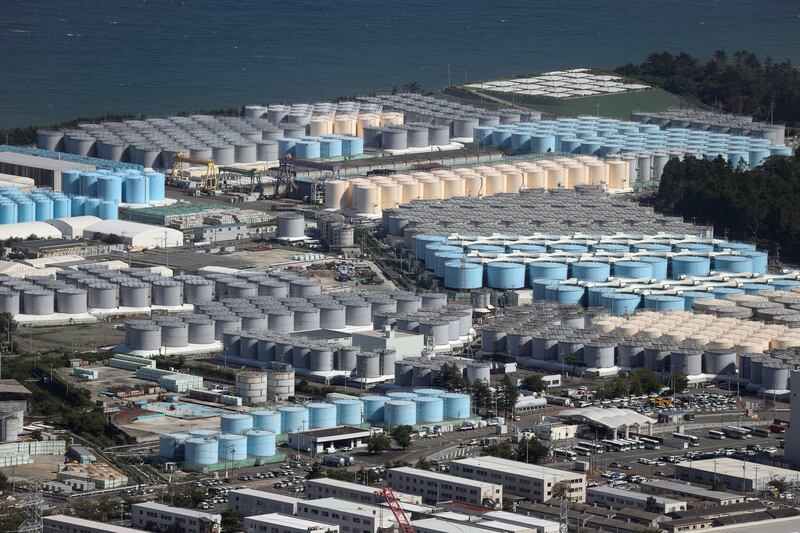The movie Oppenheimer, its star Cillian Murphy and spectacular director Christopher Nolan, have picked up 13 Oscar nominations – but film-lovers in Japan are not able to judge.
Released in the US in July, it won’t come out in Japan until March 29. The reasons lie in Japan’s tormented relationship with nuclear weapons, and nuclear power.
It appears the long wait arose from anger over the marketing tie-up “Barbenheimer” with the Barbie film, which many Japanese felt trivialised the nuclear bombings of Hiroshima and Nagasaki.
The design and development of the bomb was led by J. Robert Oppenheimer, whom Mr Murphy portrays in the film.
But some Japanese suggest the government was also glad for the film’s release to be delayed, so that it would not interfere with its plans to restart shuttered nuclear reactors.
Despite its wartime trauma, Japan enthusiastically adopted civil nuclear power, opening its first power plant in 1966, and expanding after the first oil crisis in 1973, which revealed its overdependence on suddenly expensive imported crude. By 2010, a quarter of its electricity came from its fleet of reactors.
But it then suffered another nuclear shock, when the magnitude 9 Tohoku earthquake hit in March 2011. The resulting tsunami flooded the cooling systems at the Fukushima nuclear plant, leading to a meltdown. Although only one person was confirmed to have died from radiation exposure – in 2018 – all 54 of the country’s reactors were shut down for checks and safety upgrades against any possible repeat.
Inside the damaged Fukushima nuclear power plant in Japan

Japan suffered electricity shortages and had to introduce stringent conservation measures. It increased imports of liquefied natural gas, causing a spike in worldwide prices.
Another earthquake struck the Noto Peninsula on January 1 this year. Though much smaller than the Tohoku quake at magnitude 7.6, it was still the biggest in the area since records began in 1885, and caused some damage to the mothballed Shika nuclear power plant nearby.
Nevertheless, the Japanese government has remained keen to bring its nuclear plants back on line. This would ease the country’s energy import bill and bring it closer to its net-zero carbon goals. This aim was made even more acute in 2022 by the huge rise in gas prices as Europe sought alternative gas to replace supplies cut off by Russia.
Of the 33 reactors that remain operable, 12 have come back into operation since the Fukushima accident. But in January, the restart of another plant, Onagawa 2, was delayed for several months since safety upgrade work was not yet completed. An implied goal of restarting almost all the remaining reactors by 2030 looks challenging, as public opposition continues.
Renewables, particularly solar power, have boomed, but Japan still remains short of generation capacity when accidents or cold weather strike.
Nevertheless, the combination of reactor restarts and expanded renewables capacity has had an impact.
LNG imports have dropped steadily since 2021, and in January, were finally back to pre-Fukushima levels. After briefly retaking the top spot from China in 2022, Japan has now definitively fallen behind as the world’s biggest LNG importer.
The two other major East Asian LNG importers, South Korea and Taiwan, see their nuclear paths diverging. South Korea joined Japan in the Cop28 declaration on tripling nuclear capacity worldwide by 2050, while Taiwan, which could not attend officially, did not.
They face similar challenges to Japan’s: densely-populated, mountainous countries with very little fossil fuel resources of their own, limited land for large-scale renewables, and geology not favourable for carbon capture and storage. But in contrast to their neighbour, both are recording significant growth in demand, making new power generation even more urgent. Geothermal and offshore wind are promising, but are at early stages of development.
The previous government in Seoul planned to reduce the share of nuclear capacity, but again, climate concerns and the Ukraine crisis prompted a rethink amid soaring power demand for data centres and semiconductor factories. President Yoon Suk Yeol’s administration has begun serious discussions on building two to four new nuclear plants, though any firm announcement probably has to come after elections on April 10.
South Korea also has, of course, a successful business exporting nuclear reactors, notably, constructing the UAE’s Barakah plant. And it is developing the Smart small modular reactor, which could be safer and quicker to build than large conventional plants. Saudi Arabia is working with the Koreans to commercialise the reactor.
Watch nuclear fusion inside reactor

In contrast, the newly elected president in Taipei, Lai Ching-te, who will take on the role in May, campaigned on closing the country’s last nuclear power plant by 2025, after a referendum in 2021 on phase-out led to two being shut under the incumbent. In contrast, the opposition parties had supported restarting these facilities.
Yet Mr Lai may need to think again. Tensions with Beijing are high, and the island could be blockaded in the event of conflict. Without nuclear power, most of its electricity comes from fossil fuels, yet it has a net-zero target by 2050.
Falling LNG consumption in these established East Asian markets is crucial for the global picture. First, it helps ease the supply-demand balance since the shock of 2022. That will be amplified once major new supplies hit the market from the US, Africa and Qatar from 2026 onwards.
Second, China, now the leader in volumes, is much more flexible because it can turn to other gas imports, its own domestic output and coal when LNG prices appear excessive. It consequently pays a lower price than its neighbours: just $12 per million British thermal units last March, for instance, compared to about $18 for South Korea, $15 for Japan and $14 for Taiwan. It is therefore both less reliable and less profitable for LNG sellers, although too big to ignore.
The story of nuclear power in East Asia highlights the modern global themes of energy security, affordability and climate. It also illustrates how growth in new technologies is unexpectedly raising electricity requirements, and how changes in one energy source ripple through interconnected global markets.
Oppenheimer and Fukushima cast long shadows, in Japan more than anywhere. It’s not surprising these East Asian nations regard nuclear power with some trepidation.
But a nuclear revival is increasingly likely – and essential.
Robin M. Mills is chief executive of Qamar Energy and author of The Myth of the Oil Crisis






